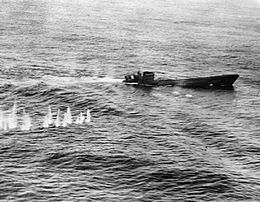U 426
|
U 426 ( previous / next - all submarines ) |
|
|---|---|
 The sinking U 426 , Jan. 8, 1944 |
|
| Type : | VII C |
| Field Post Number : | 46 323 |
| Shipyard: | Gdansk Shipyard in Gdansk |
| Construction contract: | June 5, 1941 |
| Build number: | 128 |
| Keel laying: | July 24, 1942 |
| Launch: | February 6, 1943 |
| Commissioning: | May 12, 1943 |
| Commanders: |
First Lieutenant |
| Flotilla: |
|
| Calls: | 2 activities |
| Sinkings: |
1 ship with 6,625 GRT sunk |
| Whereabouts: | sunk in the North Atlantic on January 8, 1944 |
U 426 was a German type VII C submarine .
This class of submarines was also called "Atlantic boat". It was used by the Kriegsmarine during the submarine war .
Technical specifications
The Gdansk shipyard was following the invasion of Poland commissioned the construction of submarines for the Navy, and was intended for the annual production of twelve VII-C boats. The shipyard produced a total of 42 submarines until the city was taken by the Red Army .
U 422 was part of the seventh construction contract for this shipyard, which included a total of four Type VII C boats. Such a boat had a length of 67 m and a displacement of 865 m³ under water. It was powered by two diesel engines that ensured a speed of 17 knots . Two electric motors produced a speed of 7 knots under water . Until 1944, the armament consisted of an 8.8 cm cannon and a 2.0 cm flak on deck as well as four bow torpedo tubes and a stern torpedo tube. On the tower , U 426 wore the Olympic rings, the crew mark of the officer class of the commandant Christian Reich.
Commitment and history
Until September 1943, the boat was under the 8th U-Flotilla, a training unit, and undertook training trips in the Baltic Sea to train the crew. On September 14, U 426 left Kiel for its first venture. This was also a transfer trip to Brest , the base of the 1st U-Flotilla. During this voyage, the boat was involved in the first skirmishes. During the attack on a British freighter, Commander Reich shot a torpedo fan and registered a hit. No further observations could be made because U 426 was forced to dive by an attacking destroyer. A short time later U 842 sighted Essex Lance lifeboats in this area . The sinking of this 6,625 GRT steamer was then credited to Kommandant Reich.
Sinking
Commandant Reich had been on his second patrol with U 426 for five days when the boat was attacked by a Sunderland flying boat around noon on January 8, 1944 . The German submarine initially fought back with artillery, but then stopped defensive measures when the British aircraft in turn began to fire. The Sunderland finished U 426 in a second approach with depth charges , which triggered an explosion, which resulted in decreased the German U-boat. The British aviators registered 40 men in the water, none of whom could be saved.
Individual evidence
- ^ Paul Kemp: The German and Austrian submarine losses in both world wars. Urbes Verlag, Graefelfing vor München 1998, ISBN 3-924896-43-7 , p. 170.
literature
- Rainer Busch, Hans-Joachim Röll: The submarine war 1939-1945. Volume 2: U-boat construction in German shipyards. ES Mittler und Sohn, Hamburg et al. 1997, ISBN 3-8132-0512-6 .
- Clay Blair : The Submarine War. Volume 2: The Hunted, 1942–1945. Heyne, Munich 1998, ISBN 3-453-16059-2 .